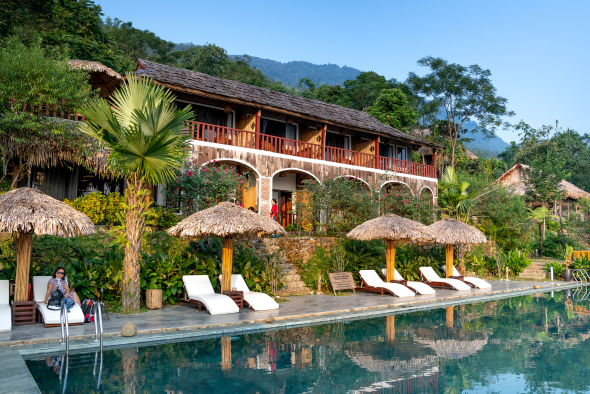What are the different types of hotels?
There are many different modes of hotel classification, such star rating, size, services or guest demographic. There are also different types of lodging: hotels, motels, hostels, resorts and B&Bs.
Travellers are a diverse bunch. A backpacker on a six month South American adventure will be looking for very different accommodation to a millionaire on a weekend trip to Dubai. This is why there are so many different types of hotels. But what exactly are those hotel types?
The ultimate solution for small hotel types
Say hello to the best team member you’ll ever employ. As an all-in-one booking and property management solution, we're designed to meet the every need of an independent hotelier.
Learn moreWhy you need to know the different types of hotels
In this guide, we’ll be looking at the different types of hotels and their categorisations, as by gaining a deeper understanding of the hotel categories your hotel occupies, the better positioned you are to identify the amenities, services, prices and atmosphere that will earn you bookings, and the better you’ll be able to understand and sell yourself to your target audience.
Common hotel classifications
Let’s begin our analysis of different types of accommodation by looking at classes of hotels. There are a wealth of ways you can classify accommodation, but here are seven of the most common.
1. Star rating
An AA hotel star rating is a number, between one and (usually) five, that is given to a hotel based on assessment criteria like cleanliness, service quality and delivery, hospitality, amenities and maintenance. Unlike star ratings from guests on review platforms, a two-star hotel can actually offer an amazing experience – the star rating just means it’s a simpler, more budget option.
2. Levels of services
A substitute for the AA star rating system, hotels can be described by their level of service: budget, mid-range, boutique or luxury.
3. Ownership
Ownership is another way to separate different kinds of hotels. Ownership types include independent/proprietary ownership, franchises, chains and long-term contracted management.
4. Target market
Hotels can be grouped by the sort of guest they target, such as families, business travellers, backpackers, couples, luxury travellers or military.
5. Size
This list of lodging types is perhaps the simplest of all. If someone asks “what are three different types of hotel properties?” you can say small (<25 rooms), medium (26-300 rooms) and large (>300 rooms).
6. Length of stay
Some lodging examples, such as motels and airport hotels, cater to guests looking for particularly short stays. Others, such as certain apartment hotels, target a longer-term guest who might stay weeks, months or more.

15 types of hotels
Another way to classify hotels is by type. While this classification can offer up endless hotel examples, the 15 types of hotels listed below are a few of the most common.
- Boutique hotel: Smaller, independent hotels that tend to offer a higher-end guest experience and may cater to a more specific demographic.
- Chain hotel: National or multinational hotel companies that aim to offer a consistent experience across all properties.
- Resort: Destination hotels that are usually big on amenity and are often (but not always) family-focused.
- Business hotel: Accommodation for corporate travellers, offering business amenities and focusing on shorter-term stays.
- Budget hotel: Cost-effective accommodation that trades luxury for simplicity and is less focused on amenity.
- Luxury hotel: High-end accommodation that aims to offer the finest possible guest experience.
- Bed and breakfast (B&B): Short-term, boutique accommodation aimed at couples. B&Bs often sell themselves to particular niches – as a pet-friendly hotel, for example.
- Extended stay hotel: Accommodation designed for longer-term stays, usually offering in-room cooking facilities.
- Airport hotel: Short stay accommodation well positioned for travellers flying in and out of a destination.
- Hostel: Budget backpacker-focused accommodation that usually offers beds in a communal dorm setting.
- Motel: Short stay accommodation located on major thoroughfares that caters to drivers and road-trippers.
- Themed hotel: Accommodation designed around a specific motif, which can be seen and felt in design, amenities and service from staff.
- Historic hotel: A particularly old hotel, or a hotel of particular significance, that uses its own history as its theme.
- Spa hotel: A hotel that features a day spa and offers a range of health and wellness services.
- Vacation rental: Holiday homes that are often privately owned and generally cater to families and groups.
List of hotel lodging types
Just as hotels can be classified, so too can the rooms within. The most common hotel lodging types include:
- Single room: Rooms with a single bed.
- Double room: Rooms with a double or queen bed.
- Twin room: Rooms with two single beds.
- Suite: A lodging that features multiple rooms, such as a bedroom and living area.
- Standard room: The most basic offering at a given hotel. (Note that the standard room of a one-star hotel will be very different from the standard room of a five-star hotel.)
- Deluxe room: A slightly larger, more luxurious, better positioned and/or amenity-filled version of a standard room.
- Connecting rooms: Side-by-side rooms with a shared door that allows guests to move between rooms without entering communal areas.
- Family room: Larger lodgings with multiple beds and often multiple rooms.
- Studio: A single room that combines living, sleeping and (sometimes) dining space.
- Villa: A more private, often detached room that offers guests a more intimate and luxurious stay.
By Shine Colcol
Shine is the SEO and Content Manager of Little Hotelier, the all-in-one software solution purpose-built to make the lives of small accommodation providers easier. With more than five years of experience and expertise in content strategy, creation, and management, Shine has produced informational content across various topics, mostly around improving daily operations and increasing business metrics. She aims to share well-researched articles in hopes of helping bed and breakfast owner-operators win more bookings and gain more control of their small property.
Table of contents
“With the mobile app, you can run your business from wherever. It's incredibly user-friendly and straightforward. Little Hotelier also offers 24/7 customer service.”
Owner, Sundowner Twin Towns Motel









Clint MacWhinnie,
General Manager
The Blazing Donkey Hotel